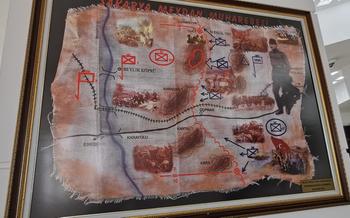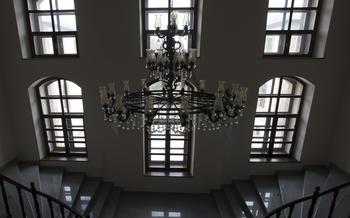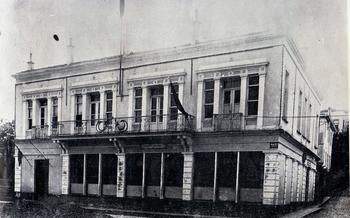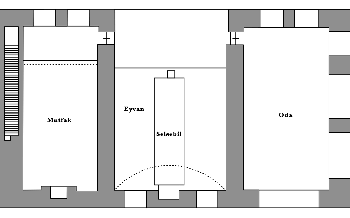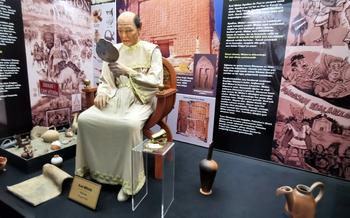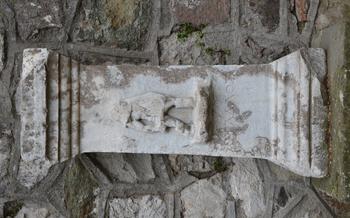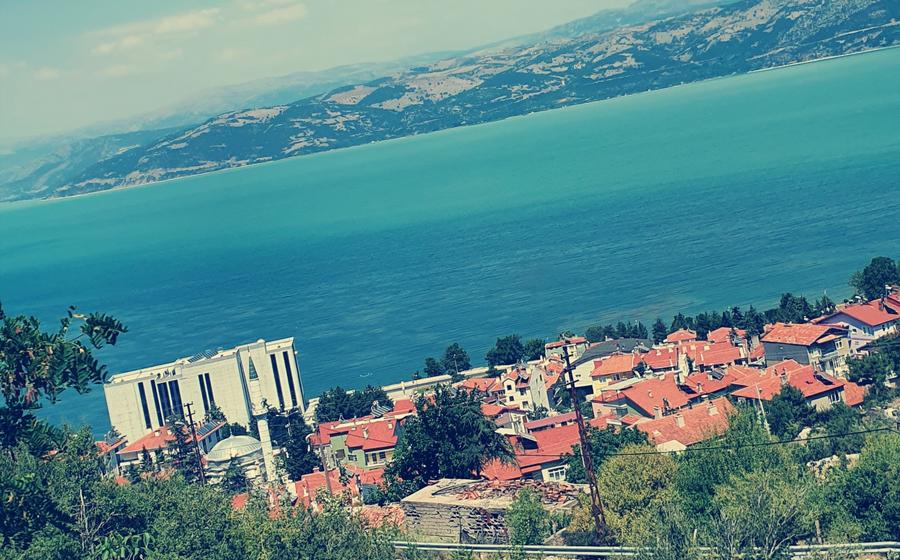
The House of Atatürk in Isparta
- A Symbol of National Pride
- Location and Accessibility
- Hours of Operation and Admission Fees
- Exploring the Museum
- Historical Context
- Architectural Heritage
- Atatürk's Legacy
- Personal Touches
- Educational Value
- Cultural Significance
- Taking Photographs
- Souvenirs and Mementos:
- Local Cuisine and Dining Options
- Combining with Other Attractions
- Insider Tip: Unveiling Hidden Treasures
A Symbol of National Pride
The House of Atatürk in Isparta stands as a revered symbol of Turkish national pride, embodying the legacy of the country's founding father, Mustafa Kemal Atatürk. During the tumultuous years of the Turkish War of Independence, this unassuming residence served as Atatürk's headquarters, a strategic command center from which he orchestrated the nation's struggle for freedom. The house, a testament to Turkish craftsmanship, showcases exquisite architectural features and design elements, blending traditional and modern styles. Its transformation into a museum has preserved Atatürk's legacy, allowing visitors to delve into his personal belongings and immerse themselves in the history of this remarkable leader. Today, the House of Atatürk is a national monument and a popular tourist attraction, drawing visitors from far and wide who seek to connect with the spirit of Turkey's revered founding father.
Location and Accessibility
The House of Atatürk is conveniently located in the heart of Isparta, at Atatürk Caddesi No: 1, just a short walk from the city's main square. Visitors can easily reach the museum on foot or by taking public transportation. Several bus lines stop nearby, and there are designated parking areas for those arriving by car. The museum is fully accessible for visitors with disabilities, with ramps and elevators providing easy access to all floors.
Hours of Operation and Admission Fees
The House of Atatürk is open to visitors from [Day of the Week] to [Day of the Week], from [Opening Time] to [Closing Time]. It is recommended to check the official website or contact the museum directly for any updates or seasonal variations in operating hours.
Admission fees for adults are [Price], while children under a certain age (usually 12 or 18) and students with valid identification may be eligible for discounted rates. Group discounts may also be available for organized tours or educational visits.
Guided tours are offered in various languages, including English, Turkish, and other languages upon request, and are led by knowledgeable and experienced museum guides. Audio guides are also available for self-guided tours, providing in-depth information and insights into the exhibits.
Advance booking or reservations are recommended, especially for group visits, to avoid waiting times or ensure a spot on a guided tour. Online booking options or contact information can be found on the museum's website or through local tourism offices.
Exploring the Museum
The House of Atatürk is a fascinating museum that offers visitors a glimpse into the life and achievements of the founder of modern Turkey. The museum is well-organized and laid out, with exhibits that showcase Atatürk's personal belongings, photographs, and documents.
Highlights of the museum include:
- Atatürk's bedroom: This room has been preserved in its original state, with Atatürk's bed, desk, and other personal items on display.
- The study: This room was where Atatürk spent much of his time working and meeting with visitors. It contains his desk, chairs, and a large map of Turkey.
- The reception room: This room was used to receive guests and hold meetings. It contains a large fireplace, a sofa, and several chairs.
- The dining room: This room was where Atatürk and his guests ate their meals. It contains a large table, chairs, and a sideboard.
- The library: This room contains a collection of books on history, politics, and military strategy. It was one of Atatürk's favorite places to relax and read.
Interactive displays and multimedia presentations help to bring Atatürk's story to life and make the museum experience more engaging for visitors of all ages.
Historical Context
During the Turkish War of Independence, Isparta played a pivotal role as a strategic location for the resistance movement led by Mustafa Kemal Atatürk. Its central position and proximity to the front lines made it an ideal base for military operations and political decision-making. Recognizing its significance, Atatürk chose to establish his headquarters in Isparta, specifically selecting the House of Atatürk as his residence and command center. This decision proved to be crucial, as Isparta became the nerve center of the Turkish nationalist movement and the birthplace of many significant decisions that shaped the course of the war.
Atatürk's stay in Isparta marked a turning point in the conflict. His leadership and strategic prowess rallied the Turkish forces and inspired the nation to unite against the invading powers. From the House of Atatürk, he issued commands, coordinated military maneuvers, and forged alliances with local leaders. His presence in Isparta boosted the morale of the troops and instilled a sense of confidence among the Turkish people, who saw him as a beacon of hope and determination.
The successful outcome of the Turkish War of Independence and the establishment of the Republic of Turkey were largely attributed to Atatürk's wise leadership and strategic decisions made during his time in Isparta. The city remains forever etched in Turkish history as a symbol of resistance, unity, and the birth of a modern nation.
Architectural Heritage
The House of Atatürk stands as a testament to the rich architectural heritage of Turkey, blending traditional and modern elements in a harmonious design. Constructed using local materials and showcasing the skills of Turkish craftsmen, the house features distinctive architectural details that set it apart. Bay windows and balconies add a touch of elegance to the exterior, while intricate stonework adorns the facade, showcasing the artistry and attention to detail that went into its construction. Restoration efforts have been meticulous in preserving the house's original character and charm, ensuring that visitors can appreciate its architectural beauty and historical significance for generations to come.
Atatürk's Legacy
Mustafa Kemal Atatürk, revered as the Father of the Turkish Nation, left an indelible mark on Turkey's history through his visionary leadership and transformative reforms. As the founder of the Republic of Turkey, Atatürk embarked on a modernization journey, ushering in progressive policies that propelled the country towards becoming a secular, democratic nation.
His principles and ideals, known as Kemalism, became the guiding force behind Turkey's transformation. Atatürk's reforms encompassed various aspects of Turkish society, including the adoption of the Latin alphabet, the establishment of secular education, and the emancipation of women. These reforms aimed to create a modern, progressive society that embraced scientific and technological advancements.
Atatürk's legacy extends beyond Turkey's borders, as he is recognized as a prominent figure in global history. His leadership during the Turkish War of Independence and his subsequent reforms earned him international acclaim and admiration. Atatürk's principles of nationalism, secularism, and modernization continue to inspire and influence leaders and nations worldwide.
Personal Touches
Beyond its historical significance, the House of Atatürk offers visitors a glimpse into the personal life of the great leader. Through his belongings and personal items, visitors can gain insights into his tastes, preferences, and daily routine. The furniture, books, and objects on display reflect his personality and provide a sense of intimacy with the man who shaped Turkey's destiny. Anecdotes and stories related to his time spent in the house add to the charm and emotional connection that visitors feel to Atatürk's presence. Whether it's the armchair where he relaxed after a long day of work or the books that he read, each item in the museum tells a story and helps visitors to connect with Atatürk on a more personal level.
Educational Value
The House of Atatürk serves as a valuable educational resource, offering visitors the opportunity to delve into Turkish history, culture, and Atatürk's contributions. Interactive exhibits and educational programs bring history to life, making learning engaging and enjoyable. Visitors can explore the house and its artifacts, gaining insights into Atatürk's life and the challenges he faced during the Turkish War of Independence. The museum's exhibits provide a comprehensive overview of Atatürk's reforms and modernization efforts, showcasing his vision for a modern and progressive Turkey. Through interactive displays and multimedia presentations, visitors can learn about the principles and ideals of Kemalism, Atatürk's enduring legacy that continues to shape Turkish society. The House of Atatürk stands as a testament to the power of education in preserving and promoting a nation's history and heritage.
Cultural Significance
The House of Atatürk stands as a potent symbol of Turkish national identity and cultural heritage. Its very existence embodies the country's unwavering struggle for independence and modernization. Within its walls, visitors can trace the footsteps of a visionary leader who dedicated his life to shaping Turkey's destiny. The house serves as a tangible reminder of the sacrifices made and the triumphs achieved during this pivotal period in Turkish history.
Moreover, the house plays a crucial role in preserving and promoting Turkish traditions and values. It showcases the country's rich cultural tapestry through artifacts, photographs, and personal belongings that belonged to Atatürk. Visitors can gain insights into the daily life, customs, and beliefs of the Turkish people during the early 20th century.
As a cultural landmark, the House of Atatürk attracts visitors from around the world who seek to delve deeper into Turkey's past and its profound impact on the present. It is a place where history comes alive, inspiring awe and admiration for the nation's unwavering spirit and its enduring legacy.
Taking Photographs
Photography enthusiasts are welcome to capture the essence of the House of Atatürk through their lenses. However, certain guidelines must be followed to ensure the preservation of the exhibits and the comfort of other visitors.
Using flash photography is strictly prohibited, as the bright light can damage sensitive artifacts and disturb the tranquil atmosphere of the museum. Tripods are also not permitted, as they can obstruct the flow of visitors and pose a safety hazard.
Designated areas or viewpoints are provided within the museum, allowing visitors to take photographs without compromising the exhibits or other guests. These spots offer the best angles and lighting conditions for capturing the beauty and significance of the house.
Visitors are encouraged to take their time and explore the different exhibits, capturing the details and atmosphere that make the House of Atatürk a unique and memorable experience. By following these guidelines, visitors can create lasting memories of their visit while respecting the museum's preservation efforts.
Souvenirs and Mementos:
The House of Atatürk offers a unique opportunity to purchase souvenirs and mementos that commemorate the visit and serve as tangible reminders of Atatürk's legacy. Visitors can find a dedicated gift shop within the museum premises, where they can browse a wide selection of items inspired by the house and its historical significance.
From books and postcards to decorative items and replicas of artifacts, the gift shop offers a diverse range of souvenirs that cater to different tastes and budgets. Visitors can choose from beautifully illustrated books that delve deeper into Atatürk's life and achievements, or opt for postcards featuring stunning photographs of the house and its surroundings.
For those seeking unique and exclusive items, the museum gift shop offers limited-edition souvenirs that are not available anywhere else. These limited-edition items often commemorate special events or anniversaries related to Atatürk or the house, making them highly sought after by collectors and enthusiasts.
Whether it's a small token or a cherished keepsake, the souvenirs from the House of Atatürk hold sentimental value and serve as a reminder of the visit and the enduring legacy of Mustafa Kemal Atatürk. Visitors can take a piece of history home with them, fostering a deeper connection to the founding father of modern Turkey.
Local Cuisine and Dining Options
After immersing yourself in the history and legacy of Atatürk, take a culinary journey and savor the delights of Isparta's local cuisine. Indulge in traditional Turkish dishes that burst with flavor and reflect the region's rich culinary heritage. For a truly authentic experience, head to one of the charming local restaurants or cafes near the museum. Ask the friendly locals for their recommendations and be sure to try regional specialties like Isparta kebabı, a succulent grilled meat dish, or keşkek, a hearty wheat and meat stew. Vegetarians and vegans can find plenty of delicious options too, such as gözleme, a savory flatbread filled with various fillings, or mercimek çorbası, a comforting lentil soup. Remember to try Isparta's famous güllaç, a delicate dessert made with layers of filo pastry, milk, and rosewater syrup, for a sweet ending to your meal. Whether you're seeking a quick bite or a leisurely dining experience, Isparta's culinary scene has something to offer every palate.
Combining with Other Attractions
When planning your visit to the House of Atatürk, consider exploring other nearby attractions to immerse yourself fully in Isparta's rich history and culture. Just a short walk from the museum, you'll find the impressive Isparta Archaeological Museum, housing a vast collection of artifacts from ancient civilizations that once thrived in the region.
For a glimpse into Isparta's natural beauty, head to the nearby Eğirdir Lake, a stunning freshwater lake surrounded by picturesque landscapes. Take a leisurely stroll along the lakeshore, admire the panoramic views, or embark on a boat tour to explore the lake's hidden coves and islands.
To further delve into the region's history, visit the Isparta Carpet Museum, showcasing the exquisite craftsmanship and vibrant designs of traditional Turkish carpets. Isparta is renowned for its high-quality carpets, and this museum offers a fascinating insight into the art and techniques behind their creation.
By combining your visit to the House of Atatürk with these other attractions, you'll gain a comprehensive understanding of Isparta's cultural heritage and create a memorable travel experience.
Insider Tip: Unveiling Hidden Treasures
Venture beyond the main exhibits to discover hidden gems within the House of Atatürk. In a secluded corner of the garden, find a serene spot where Atatürk loved to relax and contemplate amidst nature's tranquility. Seek out the secret room where he held private meetings and strategic discussions, hidden behind an unassuming bookcase. Listen closely to the fascinating stories shared by the museum guides, who can reveal lesser-known anecdotes and insights about Atatürk's life and time in Isparta. These hidden treasures add a layer of intrigue and authenticity to your visit, creating a deeper connection to the legacy of this remarkable leader.

